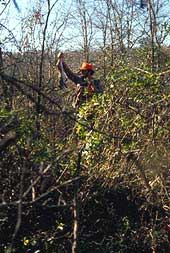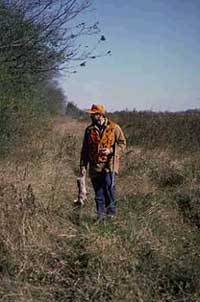
Although most rabbit hunters bag a few cottontails or swamp rabbits on each trip afield, certain techniques can bolster your success. These 12 tips should help you better enjoy the experience of rabbit hunting this season.
Tip: For beginning rabbit hunters, check out the tips in Rabbit Hunting 101 here
1. Try the Leapfrog Hunting Technique

As farming operations and urban development encroach on prime rabbit hunting areas, large contiguous blocks of hunting territory are harder to find. This has caused many rabbit hunters to abandon the traditional method of hunting all day in one large swath of brushy territory. Instead, many now opt for "leapfrogging," where hunters cover one brush patch or overgrown fence row in an hour or so, then drive on to another rabbit hideout. By leapfrogging throughout the day, hunting first one spot then another, chances are good you'll locate more rabbits.
2. Farmers Will Know Cottontail Concentrations
Savvy rabbit hunters know that farmers are an invaluable aid for finding cottontail concentrations. Since they work their land daily and see rabbits regularly, farmers know where huntable populations are likely to be. Most are eager to keep cottontails thinned out so they don't cause crop damage.
It's a simple matter to cultivate your own contacts in farm country.
Remember these hunting etiquette rules:
- Ask permission before hunting, every time you visit.
- Follow all rules the landowner asks you to abide by, like passing up shots
at the coveys of quail he's nurturing.
- Leave everything just as you found it, and always take time to thank the farmer personally.
- Offer to share your game, and follow up with a thank-you note and a token of your appreciation.
Make these easy-to-follow guidelines part of all your farm visits, and you'll always have prime rabbit lands on which to hunt.
3. Do Sunrise & Sunset Scouting for Hunting Sites
Driving rural roads near dawn and dusk is another good way to find potential hunting sites. Cottontails are most active early and late in the day, especially along the fringes of fields and roadside cover, where briars and thickets provide sanctuary near favorite feeding areas.
Drive slowly, and note any spot where you see several cottontails. Then inquire at nearby homes for the name of the landowner so you can request permission to hunt.
4. Wear Protective Clothing While Hunting
Most good cottontail thickets have one thing in common -- thorns. Whether you're hunting behind dogs, kicking up rabbits yourself or retrieving downed game, some type of sticker will be clawing at your ears, fingers, thighs and other tender parts. Wearing protective clothing can do wonders to make your trips afield more enjoyable and less painful.
Blue jeans are preferred by many rabbit fans, but offer little protection. A good pair of briar-busting breeches with thorn-proof material covering the front should be considered essential equipment no matter where and how you hunt. I suggest hunting chaps like the Cabela's Upland Traditions or a good pair of brush pants like Cabela's Instinct Prairie Runner. It also helps to wear a briar-resistant hunting coat, gloves and some type of hunting cap with flaps that can be pulled down over your ears.
5. Remember the Blaze Orange

A buddy of mine often describes dense rabbit cover by saying, "You couldn't see a blaze orange rhino in there." In some locales we hunt, this is darn near true. Cover is so thick, you can only see a few feet. For this reason, we wear hunter orange hats and bodywear on every trip.
Tip: Watch video: How Effective is Blaze Orange? Hunter-ed.com video shows a true comparison of the various blaze orange color types for hunting in the field.
Safety should be the foremost consideration on all your rabbit hunts. Remember the orange rhino, and make hunter orange clothing a must for everyone in your party.
6. Shotguns & Shotshells
When stomping for cottontails in thick cover, use a shotgun with an improved cylinder choke and No. 6 or 7-1/2 shotshells. Since cottontails jumped in thick cover usually are close and moving fast, a wide, yet sufficiently heavy, shot pattern is needed to put a rabbit down without excessive damage to the meat.
When hunting cottontails with beagles, you may want to switch to a modified or full choke. A pack of dogs will push rabbits across fields and woodlots, and the shots you'll make are usually farther than those presented when you flush rabbits yourself. Use the tighter patterning choke and increase your shot size to No. 4s or 6s.
7. Icy Weather = Hot Rabbit Hunting
Cold, miserable days often provide the best gunning. Rabbit fur has poor insulating qualities, so rabbits are forced to take shelter from the weather, making them easier to find and less likely to flush wildly.
To find bad-weather bunnies, think like a rabbit. Where would you go to escape the cold if all you had to wear was a light jacket? Hunt places that are sheltered from wind and open to warm rays of sunshine, then move to other locales offering protection from adverse conditions.
8. Look for the Rabbits Eyes
Stalking rabbits as they sit in their forms is great sport, especially when hunting with youngsters not yet adept at bagging running rabbits. The trick is to spot the rabbit before it spots you. Considering the rabbit's superb camouflage, this can be tough.
Old hands at this endeavor have a rule: look for their eyes instead of their whole bodies. A rabbit's round, dark eyes look out of place against the crisscross of cover, and are easily spotted by a hunter who walks slowly, carefully examining all brush and weeds. You may overlook rabbits huddled in their forms, but you'll also bag a few at close range after spotting the eye.
9. Watch Over Your Shoulder, Rabbits Can Circle Behind You
In isolated patches of cover, a cottontail may head directly away, disappearing from sight, then circle well behind the hunter. Others sit tight until the gunner passes, then squirt out behind.
Look over your shoulder every few minutes, and you'll glimpse some of these renegades before they make good their escape. Snap shooting is a must, so be careful to identify your target before shooting.
10. Stop-and-Go Hunting

A veteran nimrod taught me a rabbit hunting technique that has proven very effective over the years. It's based on the idea that rabbits are highly nervous animals, and suspense is something they can't handle very well. It works this way. Enter a covert and begin walking very slowly. Walk ten paces, then stop for at least a minute, then repeat the process. The sound of the approach is sometimes enough to make cottontails flush, but it's just as often the silent period. Apparently, the rabbits think they've been detected and decide to make a run for it.
11. Look for Woodland Rabbits
Most hunters think of thickets and field edges as the places to go for a rabbit race. Some fail to realize woods harbor rabbits, too. Look for cottontails and swamp rabbits in brushpiles, honeysuckle patches, fallen treetops, cane brakes and other forest cover. Because such areas usually receive less hunting pressure, they often hide extraordinary numbers of rabbits.
12. Take a Kid Rabbit Hunting
To get the most out of your next rabbit hunt, take a kid with you -- a son, a daughter, a niece, a nephew, a grandchild or maybe a neighbor's child. It was in the cottontail fields most of us were trained as young hunters. We may have dreamed of deer or more exotic game like grizzlies and lions, but with cottontails, we learned the crucial basics about hunting, nature and ourselves.
Share these things with children. Share the fun and excitement, the triumphs and disappointments, the barrage of wonderful sensations experienced on a rabbit hunt. Our heritage of hunting is a priceless treasure. Do your part to pass it on.
- 189195 views

